Advanced Dielectric Resonator Antenna Technology for 5G and 6G Applications
Abstract
1. Introduction
- Section 2 provides a comprehensive overview of compact off-chip DRAs and their applications in array configurations.
- Section 3 introduces the concept of on-chip DRAs, which serve as gain directors in high mmW bands.
- Section 4 reviews the state-of-the-art beam-steerable DRAs designed to operate mostly in mmW bands.
- Section 5 reviews the dual-band DRAs in shared aperture designs up to mmW bands.
2. Compact Off-Chip DRA and Array Designs toward Millimeter-Wave Frequencies
2.1. Co-Fabricated and In-Template DRAs
2.2. Compact Substrate-Integrated DRAs
3. mmW On-Chip DRAs
3.1. On-Chip Spherical Self-Aligning DRAs
3.2. On-Chip DRAs on BEOL
4. Beam-Steerable DRA Arrays
4.1. Wide-Beam DRAs
4.2. Pattern-Reconfigurable DRAs
5. Dual-Band DRAs up to the mmW Band
6. Discussion and Conclusions
Author Contributions
Funding
Conflicts of Interest
References
- Rappaport, T.S.; Xing, Y.; MacCartney, G.R.; Molisch, A.F.; Mellios, E.; Zhang, J. Overview of millimeter wave communications for fifth-generation (5G) wireless networks—With a focus on propagation models. IEEE Trans. Antennas Propag. 2017, 65, 6213–6230. [Google Scholar] [CrossRef]
- European Vision for the 6G Network Ecosystem; White Paper; The 5G Infrastructure Association: Gent, Belgium, 2021.
- Rappaport, T.S.; Xing, Y.; Kanhere, O.; Ju, S.; Madanayake, A.; Mandal, S.; Alkhateeb, A.; Trichopoulos, G.C. Wireless communications and applications above 100 GHz: Opportunities and challenges for 6G and beyond. IEEE Access 2019, 7, 78729–78757. [Google Scholar] [CrossRef]
- Nakamura, T. 5G Evolution and 6G. In Proceedings of the 2020 IEEE Symposium on VLSI Technology, Honolulu, HI, USA, 16–19 June 2020; pp. 1–5. [Google Scholar]
- Zhang, Y.; Mao, J. An overview of the development of antenna-in-package technology for highly integrated wireless devices. Proc. IEEE 2019, 107, 2265–2280. [Google Scholar] [CrossRef]
- Petosa, A. Dielectric Resonator Antenna Handbook; Artech: Norwood, MA, USA, 2007. [Google Scholar]
- Keyrouz, S.; Caratelli, D. Dielectric resonator antennas: Basic concepts, design guidelines, and recent developments at millimeter-wave frequencies. Int. J. Antennas Propag. 2016, 2016, 6075680. [Google Scholar] [CrossRef]
- Mongia, R.K.; Bhartia, P. Dielectric resonator antennas—A review and general design relations for resonant frequency and bandwidth. Int. J. Microw. Millim.-Wave Comput.-Aided Eng. 1994, 4, 230–247. [Google Scholar] [CrossRef]
- Yang, N.; Leung, K.W.; Wu, N. Pattern-diversity cylindrical dielectric resonator antenna using fundamental modes of different mode families. IEEE Trans. Antennas Propag. 2019, 67, 6778–6788. [Google Scholar] [CrossRef]
- Alroughani, H.; McNamara, D.A. The shape synthesis of dielectric resonator antennas. IEEE Trans. Antennas Propag. 2020, 68, 5766–5777. [Google Scholar] [CrossRef]
- Whiting, E.B.; Campbell, S.D.; Mackertich-Sengerdy, G.; Werner, D.H. Dielectric resonator antenna geometry-dependent performance tradeoffs. IEEE Open J. Antennas Propag. 2020, 2, 14–21. [Google Scholar] [CrossRef]
- Kishk, A.A.; Zhang, X.; Glisson, A.W.; Kajfez, D. Numerical analysis of stacked dielectric resonator antennas excited by a coaxial probe for wideband applications. IEEE Trans. Antennas Propag. 2003, 51, 1996–2006. [Google Scholar] [CrossRef]
- Chair, R.; Yang, S.L.S.; Kishk, A.A.; Lee, K.F.; Luk, K.M. Aperture fed wideband circularly polarized rectangular stair shaped dielectric resonator antenna. IEEE Trans. Antennas Propag. 2006, 54, 1350–1352. [Google Scholar] [CrossRef]
- Chu, H.; Guo, Y.X. A novel approach for millimeter-wave dielectric resonator antenna array designs by using the substrate integrated technology. IEEE Trans. Antennas Propag. 2016, 65, 909–914. [Google Scholar] [CrossRef]
- Omar, A.A.; Park, J.; Kwon, W.; Hong, W. A compact wideband vertically polarized end-fire millimeter-wave antenna utilizing slot, dielectric, and cavity resonators. IEEE Trans. Antennas Propag. 2021, 69, 5234–5243. [Google Scholar] [CrossRef]
- Federico, G.; Hubrechsen, A.; Coenen, S.L.; Reniers, A.C.; Caratelli, D.; Smolders, A.B. A wide-scanning Metasurface antenna Array for 5G Millimeter-wave communication devices. IEEE Access 2022, 10, 102308–102315. [Google Scholar] [CrossRef]
- Liu, Y.T.; Ma, B.; Huang, S.; Wang, S.; Hou, Z.J.; Wu, W. Wideband Low-Profile Connected Rectangular Ring Dielectric Resonator Antenna Array for Millimeter-Wave Applications. IEEE Trans. Antennas Propag. 2022, 71, 999–1004. [Google Scholar] [CrossRef]
- Li, Y.; Luk, K.M. A 60-GHz dense dielectric patch antenna array. IEEE Trans. Antennas Propag. 2013, 62, 960–963. [Google Scholar] [CrossRef]
- Al-Alem, Y.; Kishk, A.A. High-gain 60 GHz slot antenna with symmetric radiation characteristics. IEEE Trans. Antennas Propag. 2019, 67, 2971–2982. [Google Scholar] [CrossRef]
- Al-Alem, Y.; Kishk, A.A. Wideband millimeter-wave dielectric resonator antenna with gain enhancement. IEEE Antennas Wirel. Propag. Lett. 2019, 18, 2711–2715. [Google Scholar] [CrossRef]
- Mazhar, W.; Klymyshyn, D.; Wells, G.; Qureshi, A.; Jacobs, M. 60 GHz substrate integrated waveguide-fed monolithic grid dielectric resonator antenna arrays. IEEE Antennas Wirel. Propag. Lett. 2019, 18, 1109–1113. [Google Scholar] [CrossRef]
- Qureshi, A.A.; Klymyshyn, D.M.; Tayfeh, M.; Mazhar, W.; Börner, M.; Mohr, J. Template-based dielectric resonator antenna arrays for millimeter-wave applications. IEEE Trans. Antennas Propag. 2017, 65, 4576–4584. [Google Scholar] [CrossRef]
- Kremer, H.I.; Leung, K.W.; Lee, M.W. Compact wideband low-profile single-and dual-polarized dielectric resonator antennas using dielectric and air vias. IEEE Trans. Antennas Propag. 2021, 69, 8182–8193. [Google Scholar] [CrossRef]
- Kremer, H.I.; Leung, K.W.; Lee, M.W. Design of substrate-integrated dielectric resonator antenna with dielectric vias. IEEE Trans. Antennas Propag. 2021, 69, 5205–5214. [Google Scholar] [CrossRef]
- Tong, C.; Kremer, H.I.; Yang, N.; Leung, K.W. Compact wideband circularly polarized dielectric resonator antenna with dielectric vias. IEEE Antennas Wirel. Propag. Lett. 2022, 21, 1100–1104. [Google Scholar] [CrossRef]
- Tang, H.; Deng, X.; Shi, J. Wideband substrate integrated differential dual-polarized dielectric resonator antenna. IEEE Antennas Wirel. Propag. Lett. 2021, 21, 203–207. [Google Scholar] [CrossRef]
- Yang, M.D.; Pan, Y.M.; Sun, Y.X.; Leung, K.W. Wideband circularly polarized substrate-integrated embedded dielectric resonator antenna for millimeter-wave applications. IEEE Trans. Antennas Propag. 2019, 68, 1145–1150. [Google Scholar] [CrossRef]
- Liu, Y.T.; Leung, K.W. 28 GHz Substrate-Integrated Filtering Dielectric Resonator Antenna Array. IEEE Trans. Antennas Propag. 2022, 70, 9900–9905. [Google Scholar] [CrossRef]
- Sun, Y.X.; Leung, K.W. Circularly polarized substrate-integrated cylindrical dielectric resonator antenna array for 60 GHz applications. IEEE Antennas Wirel. Propag. Lett. 2018, 17, 1401–1405. [Google Scholar] [CrossRef]
- Ma, C.; Zheng, S.Y.; Pan, Y.M.; Chen, Z. Millimeter-Wave Fully Integrated Dielectric Resonator Antenna and Its Multi-Beam Application. IEEE Trans. Antennas Propag. 2022, 70, 6571–6580. [Google Scholar] [CrossRef]
- Ma, C.J.; Pan, Y.M.; Meng, X.Y.; Zheng, S.Y. A Microwave/Millimeter-Wave Shared-Aperture Antenna Based on Slow-Wave Parallel-Plate Waveguide. IEEE Trans. Antennas Propag. 2023, 71, 3022–3032. [Google Scholar] [CrossRef]
- Chen, Z.; Shen, C.; Liu, H.; Ye, X.; Qi, L.; Yao, Y.; Yu, J.; Chen, X. Millimeter-wave rectangular dielectric resonator antenna array with enlarged DRA dimensions, wideband capability, and high-gain performance. IEEE Trans. Antennas Propag. 2019, 68, 3271–3276. [Google Scholar] [CrossRef]
- Available online: https://www.rogerscorp.com (accessed on 1 December 2023).
- Movahedinia, R.; Sebak, A.R.; Chaharmir, M.R.; Nikkhah, M.R.; Kishk, A.A. X-band circularly polarized electronically steerable parasitic Array radiator of DRA. IEEE Trans. Antennas Propag. 2017, 66, 721–728. [Google Scholar] [CrossRef]
- Zhang, Y.; Kishk, A. Study of embedded dielectric resonator antennas using perforated dielectric materials for wideband applications. In Proceedings of the 2006 IEEE Antennas and Propagation Society International Symposium, Albuquerque, NM, USA, 9–14 July 2006; pp. 1321–1324. [Google Scholar]
- Li, H.; Cheng, Y.; Mei, L.; Guo, L. Frame integrated wideband dual-polarized arrays for mm-wave/sub 6-GHz mobile handsets and its user effects. IEEE Trans. Veh. Technol. 2020, 69, 14330–14340. [Google Scholar] [CrossRef]
- Liu, Y.T.; Leung, K.W.; Ren, J.; Sun, Y.X. Linearly and circularly polarized filtering dielectric resonator antennas. IEEE Trans. Antennas Propag. 2019, 67, 3629–3640. [Google Scholar] [CrossRef]
- Sallam, M.O.; Serry, M.; Sedky, S.; Shamim, A.; De Raedt, W.; Vandenbosch, G.A.; Soliman, E.A. Micromachined on-chip dielectric resonator antenna operating at 60 GHz. IEEE Trans. Antennas Propag. 2015, 63, 3410–3416. [Google Scholar] [CrossRef]
- Jenning, M.; Klein, B.; Hahnel, R.; Plettemeier, D. On-chip integrated antennas for 200 GHz applications. In Proceedings of the 2015 IEEE International Conference on Ubiquitous Wireless Broadband (ICUWB), Montreal, QC, Canada, 4–7 October 2015; pp. 1–5. [Google Scholar]
- Emhemmed, A.S.; McGregor, I.; Elgaid, K. 200 GHz broadband proximity coupled patch antenna. In Proceedings of the 2009 IEEE International Conference on Ultra-Wideband, Vancouver, BC, Canada, 9–11 September 2009; pp. 404–407. [Google Scholar]
- de Kok, M.; Smolders, A.B.; Johannsen, U. A review of design and integration technologies for D-band antennas. IEEE Open J. Antennas Propag. 2021, 2, 746–758. [Google Scholar] [CrossRef]
- Deng, X.D.; Li, Y.; Liu, C.; Wu, W.; Xiong, Y.Z. 340 GHz on-chip 3-D antenna with 10 dBi gain and 80% radiation efficiency. IEEE Trans. Terahertz Sci. Technol. 2015, 5, 619–627. [Google Scholar] [CrossRef]
- Gashi, B.; Meier, D.; John, L.; Baumann, B.; Rösch, M.; Tessmann, A.; Leuther, A.; Quay, R. Broadband 400 GHz on-chip antenna with a metastructured ground plane and dielectric resonator. IEEE Trans. Antennas Propag. 2022, 70, 9025–9038. [Google Scholar] [CrossRef]
- Ahmad, Z.; Hesselbarth, J. On-chip dual-polarized dielectric resonator antenna for millimeter-wave applications. IEEE Antennas Wirel. Propag. Lett. 2018, 17, 1769–1772. [Google Scholar] [CrossRef]
- Marin, J.G.; Baba, A.A.; Hesselbarth, J.; Hashmi, R.M.; Esselle, K.P. Millimeter-wave low-loss multifeed superstrate-based antenna. IEEE Trans. Antennas Propag. 2020, 68, 3387–3396. [Google Scholar] [CrossRef]
- Marin, J.G.; Baba, A.A.; Cuenca, D.L.; Hesselbarth, J.; Hashmi, R.M.; Esselle, K.P. High-gain low-profile chip-fed resonant cavity antennas for millimeter-wave bands. IEEE Antennas Wirel. Propag. Lett. 2019, 18, 2394–2398. [Google Scholar] [CrossRef]
- Hou, D.; Xiong, Y.Z.; Goh, W.L.; Hu, S.; Hong, W.; Madihian, M. 130-GHz on-chip meander slot antennas with stacked dielectric resonators in standard CMOS technology. IEEE Trans. Antennas Propag. 2012, 60, 4102–4109. [Google Scholar] [CrossRef]
- Hou, D.; Hong, W.; Goh, W.L.; Chen, J.; Xiong, Y.Z.; Hu, S.; Madihian, M. D-band on-chip higher-order-mode dielectric-resonator antennas fed by half-mode cavity in CMOS technology. IEEE Antennas Propag. Mag. 2014, 56, 80–89. [Google Scholar] [CrossRef]
- Hou, D.; Hong, W.; Chen, J.; Song, Z.; Yan, P.; Xiong, Y.Z. 130 GHz on-chip dielectric resonator antenna array in CMOS technology. In Proceedings of the 2017 Sixth Asia-Pacific Conference on Antennas and Propagation (APCAP), Xi’an, China, 16–19 October 2017; pp. 1–3. [Google Scholar]
- Hou, D.; Chen, J.; Yan, P.; Hong, W. A 270 GHz × 9 multiplier chain MMIC with on-chip dielectric-resonator antenna. IEEE Trans. Terahertz Sci. Technol. 2018, 8, 224–230. [Google Scholar] [CrossRef]
- Li, C.H.; Chiu, T.Y. 340-GHz low-cost and high-gain on-chip higher order mode dielectric resonator antenna for THz applications. IEEE Trans. Terahertz Sci. Technol. 2017, 7, 284–294. [Google Scholar] [CrossRef]
- Cuenca, D.L.; Hesselbarth, J.; Alavi, G. Chip-mounted dielectric resonator antenna with alignment and testing features. In Proceedings of the 2016 46th European Microwave Conference (EuMC), London, UK, 4–6 October 2016; pp. 723–726. [Google Scholar]
- Dey, U.; Hesselbarth, J. Spherical dielectric resonator antenna operating at 180 GHz. IEEE Antennas Wirel. Propag. Lett. 2020, 19, 1380–1384. [Google Scholar] [CrossRef]
- Bijumon, P.; Antar, Y.; Freundorfer, A.; Sayer, M. Dielectric resonator antenna on silicon substrate for system on-chip applications. IEEE Trans. Antennas Propag. 2008, 56, 3404–3410. [Google Scholar] [CrossRef]
- Federico, G.; Caratelli, D.; Theis, G.; Smolders, A. A review of antenna array technologies for point-to-point and point-to-multipoint wireless communications at millimeter-wave frequencies. Int. J. Antennas Propag. 2021, 2021, 5559765. [Google Scholar] [CrossRef]
- Ogurtsov, S.; Theis, G.; Arrincon, J.; Smolders, B.; Caratelli, D. A Novel Class of Dielectric Resonator Antenna Phased Arrays with Enhanced Beam-Scanning Capabilities for mm-Wave Applications. In Proceedings of the 2022 IEEE International Symposium on Antennas and Propagation and USNC-URSI Radio Science Meeting (AP-S/URSI), Denver, CO, USA, 10–15 July 2022; pp. 1270–1271. [Google Scholar]
- Zhang, B.; Ren, J.; Yin, T.; Liu, Y.T.; Liu, Y.; Yin, Y. Design of Dielectric Resonator Antenna Array with Wide-Angle Scanning Based on Dual Magnetic Currents. IEEE Trans. Antennas Propag. 2022, 70, 11675–11685. [Google Scholar] [CrossRef]
- Wang, Z.; Zhao, S.; Dong, Y. Metamaterial-Based Wide-Beam Dielectric Resonator Antenna for Broadband Wide-Angle Beam-Scanning Phased Array Applications. IEEE Trans. Antennas Propag. 2022, 70, 9061–9072. [Google Scholar] [CrossRef]
- Su, Z.L.; Leung, K.W.; Lu, K. A Shaped-Beam Antenna for Wide-Angle Scanning Phased Array. IEEE Trans. Antennas Propag. 2022, 70, 7659–7669. [Google Scholar] [CrossRef]
- Zhang, J.E.; Zhang, Q.; Kong, W.; Yang, W.W.; Chen, J.X. Compact and Low-Profile Linear-/Circular-Polarization Dielectric Resonator Antennas with Extended Bandwidths. IEEE Open J. Antennas Propag. 2022, 3, 391–397. [Google Scholar] [CrossRef]
- Liu, Y.T.; Zhao, W.; Ma, B.; Huang, S.; Ren, J.; Wu, W.; Ma, H.Q.; Hou, Z.J. 1-D Wideband Phased Dielectric Resonator Antenna Array with Improved Radiation Performance Using Characteristic Mode Analysis. IEEE Trans. Antennas Propag. 2023, 71, 6179–6184. [Google Scholar] [CrossRef]
- Wang, Z.; Dong, Y.; Peng, Z.; Hong, W. Hybrid Metasurface, Dielectric Resonator, Low-Cost, Wide-Angle Beam-Scanning Antenna for 5G Base Station Application. IEEE Trans. Antennas Propag. 2022, 70, 7646–7658. [Google Scholar] [CrossRef]
- Wang, Z.; Zhao, S.; Dong, Y. Miniaturized, Vertically Polarized, Pattern Reconfigurable Dielectric Resonator Antenna and Its Phased Array for Wide-Angle Beam-Steering. IEEE Trans. Antennas Propag. 2022, 70, 9233–9246. [Google Scholar] [CrossRef]
- Ren, Q.; Qian, B.; Chen, X.; Huang, X.; Li, Q.; Zhang, J.; Kishk, A.A. Linear Antenna Array with Large Element Spacing for Wide-Angle Beam Scanning with Suppressed Grating Lobes. IEEE Antennas Wirel. Propag. Lett. 2022, 21, 1258–1262. [Google Scholar] [CrossRef]
- Chen, Z.; Song, Z.; Liu, H.; Liu, X.; Yu, J.; Chen, X. A compact phase-controlled pattern-reconfigurable dielectric resonator antenna for passive wide-angle beam scanning. IEEE Trans. Antennas Propag. 2020, 69, 2981–2986. [Google Scholar] [CrossRef]
- Federico, G.; Smolders, A.; Theis, G.; Caratelli, D. A Planar Multi-Mode Antenna Array with Enhanced Horizontal Scan Range for mm-Wave Applications. In Proceedings of the 2022 IEEE International Symposium on Antennas and Propagation and USNC-URSI Radio Science Meeting (AP-S/URSI), Denver, CO, USA, 10–15 July 2022; pp. 1580–1581. [Google Scholar]
- Chair, R.; Kishk, A.A.; Lee, K.F. Comparative study on the mutual coupling between different sized cylindrical dielectric resonators antennas and circular microstrip patch antennas. IEEE Trans. Antennas Propag. 2005, 53, 1011–1019. [Google Scholar] [CrossRef]
- Nikkhah, M.R.; Rashed-Mohassel, J.; Kishk, A.A. Compact low-cost phased array of dielectric resonator antenna using parasitic elements and capacitor loading. IEEE Trans. Antennas Propag. 2013, 61, 2318–2321. [Google Scholar] [CrossRef]
- Nikkhah, M.R.; Loghmannia, P.; Rashed-Mohassel, J.; Kishk, A.A. Theory of ESPAR design with their implementation in large arrays. IEEE Trans. Antennas Propag. 2014, 62, 3359–3364. [Google Scholar] [CrossRef]
- Jiahong, L.; Xiaotong, X.; Song, Q.; Yishan, L.; Peng, X.; Min, W. A wide-angle scanning phased array based on dual-mode pattern-reconfigurable dielectric resonator antennas. In Proceedings of the 2020 International Conference on Microwave and Millimeter Wave Technology (ICMMT), Shanghai, China, 20–23 September 2020; pp. 1–3. [Google Scholar]
- Wang, Z.; Dong, Y. Metamaterial-Based Pattern-Switchable Linear Array for 2-D Discrete Beam-Scanning Using Hybrid Digital Coding Method. IEEE Trans. Antennas Propag. 2023, 71, 2515–2526. [Google Scholar] [CrossRef]
- Wang, Z.; Dong, Y. Theory, Design, and Verification of Miniaturized Phase-Controlled Huygens Antenna for 360° Continuous Beam Scanning. IEEE Trans. Antennas Propag. 2023, 71, 3104–3113. [Google Scholar] [CrossRef]
- Sun, Y.X.; Leung, K.W. Substrate-integrated two-port dual-frequency antenna. IEEE Trans. Antennas Propag. 2016, 64, 3692–3697. [Google Scholar] [CrossRef]
- Cui, L.X.; Ding, X.H.; Yang, W.W.; Guo, L.; Zhou, L.H.; Chen, J.X. Communication compact dual-band hybrid dielectric resonator antenna for 5G Millimeter-wave applications. IEEE Trans. Antennas Propag. 2022, 71, 1005–1010. [Google Scholar] [CrossRef]
- Wang, Y.X.; Chen, Z.; Yuan, T. Design of a Dual-Band Dielectric Resonator Antenna Array for Millimeter-Wave Communication. IEEE Antennas Wirel. Propag. Lett. 2023, 22, 2190–2194. [Google Scholar] [CrossRef]
- Shamsaee Malfajani, R.; Niknam, H.; Bodkhe, S.; Therriault, D.; Laurin, J.J.; Sharawi, M.S. A 3D-printed Encapsulated Dual Wide-Band Dielectric Resonator Antenna with Beam Switching Capability. IEEE Open J. Antennas Propag. 2023, 4, 492–505. [Google Scholar] [CrossRef]

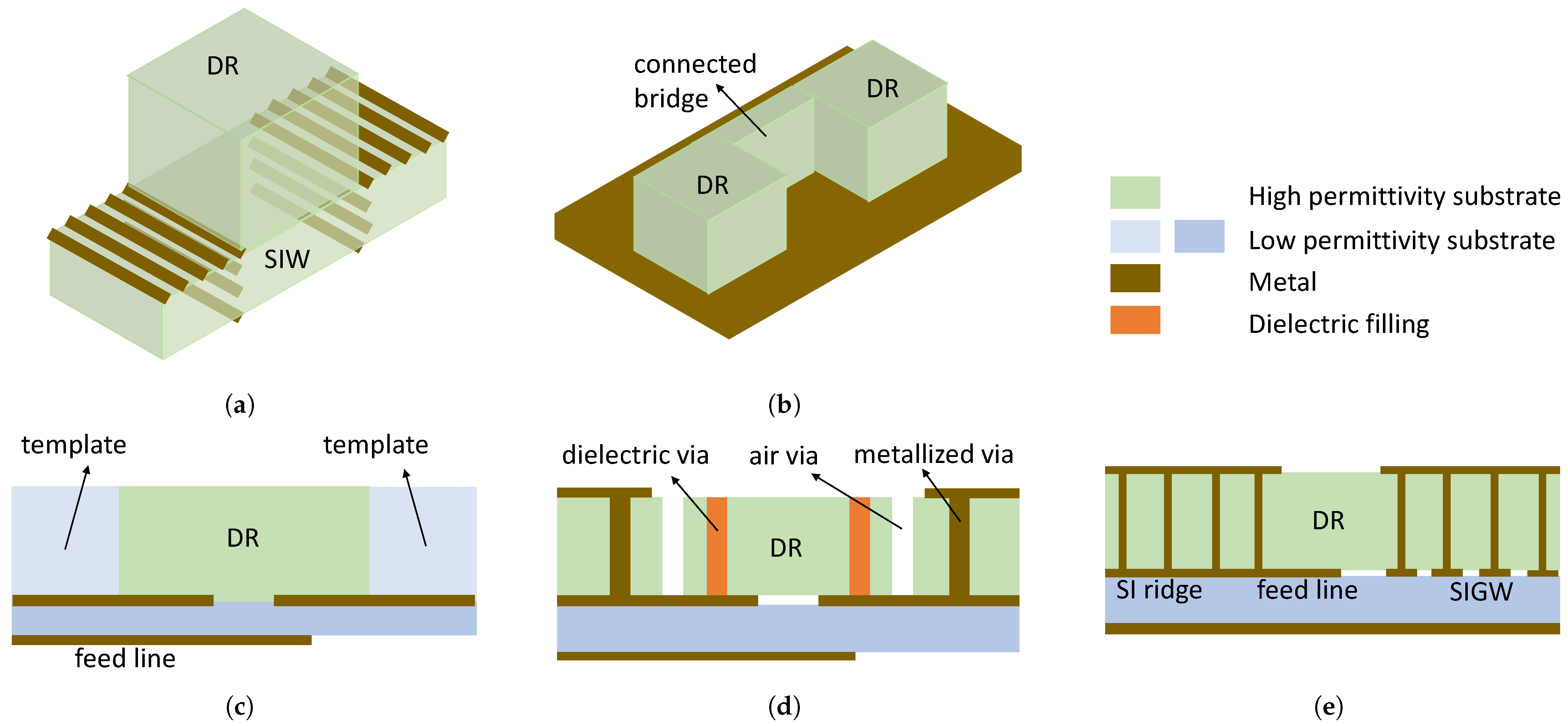
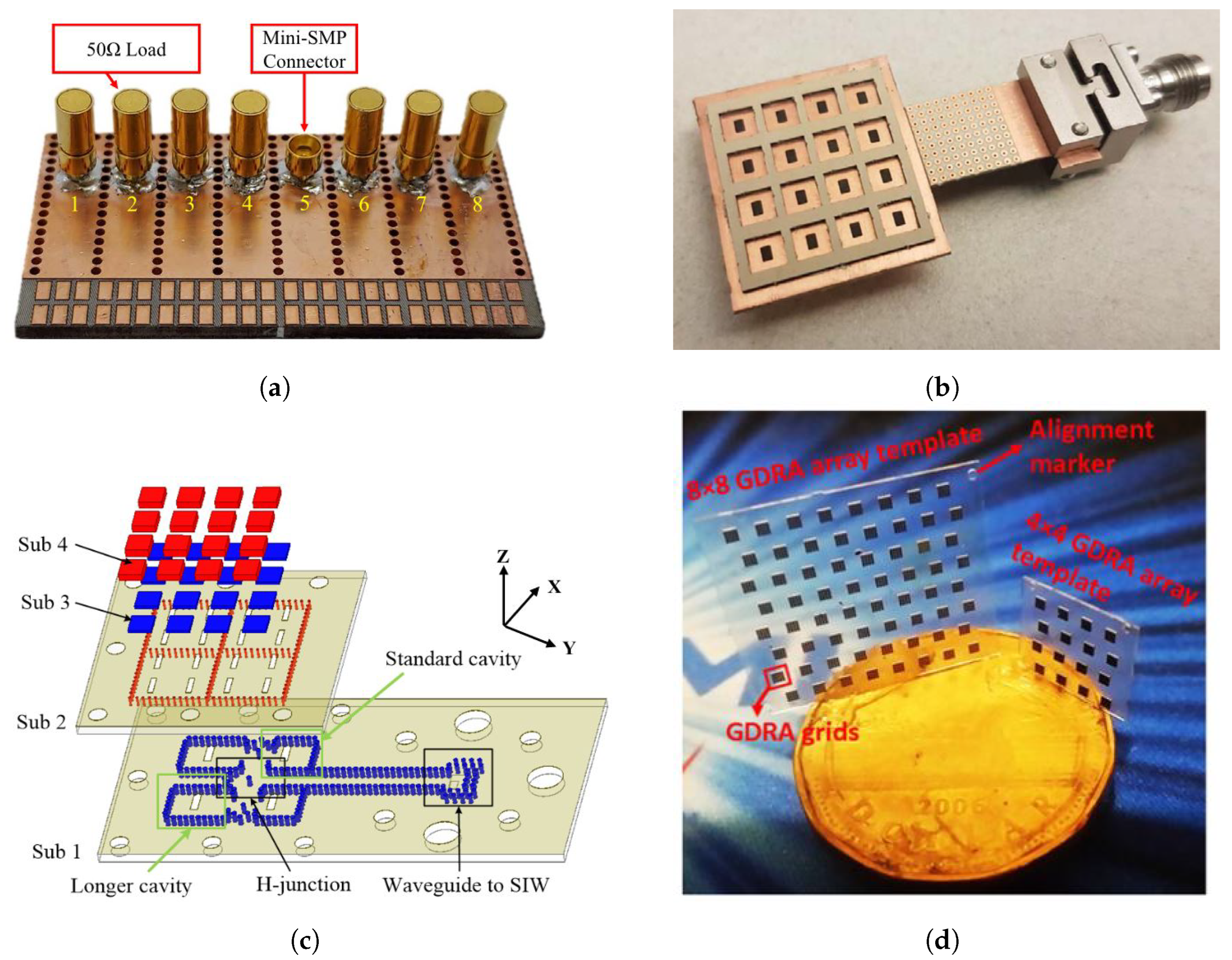
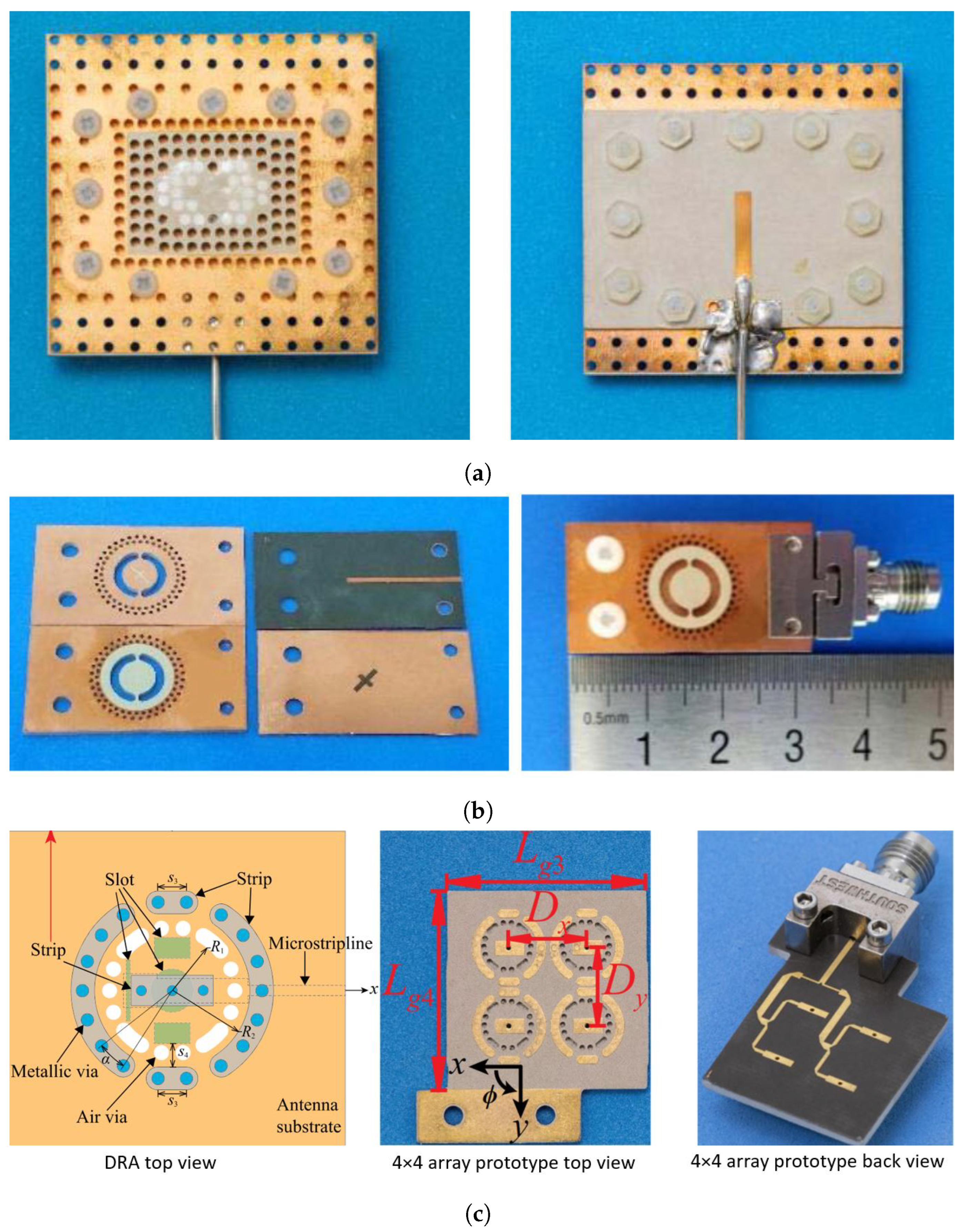


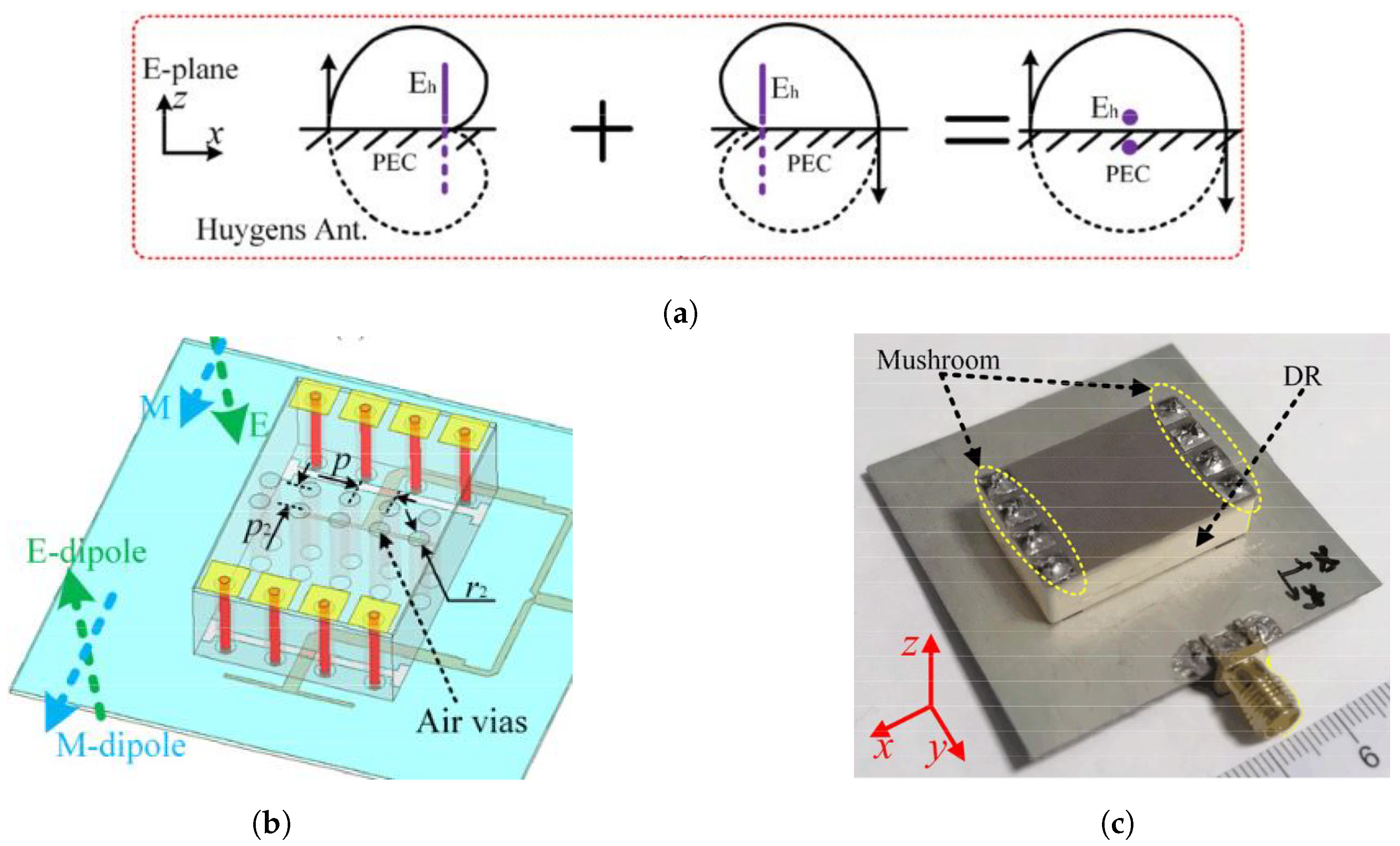
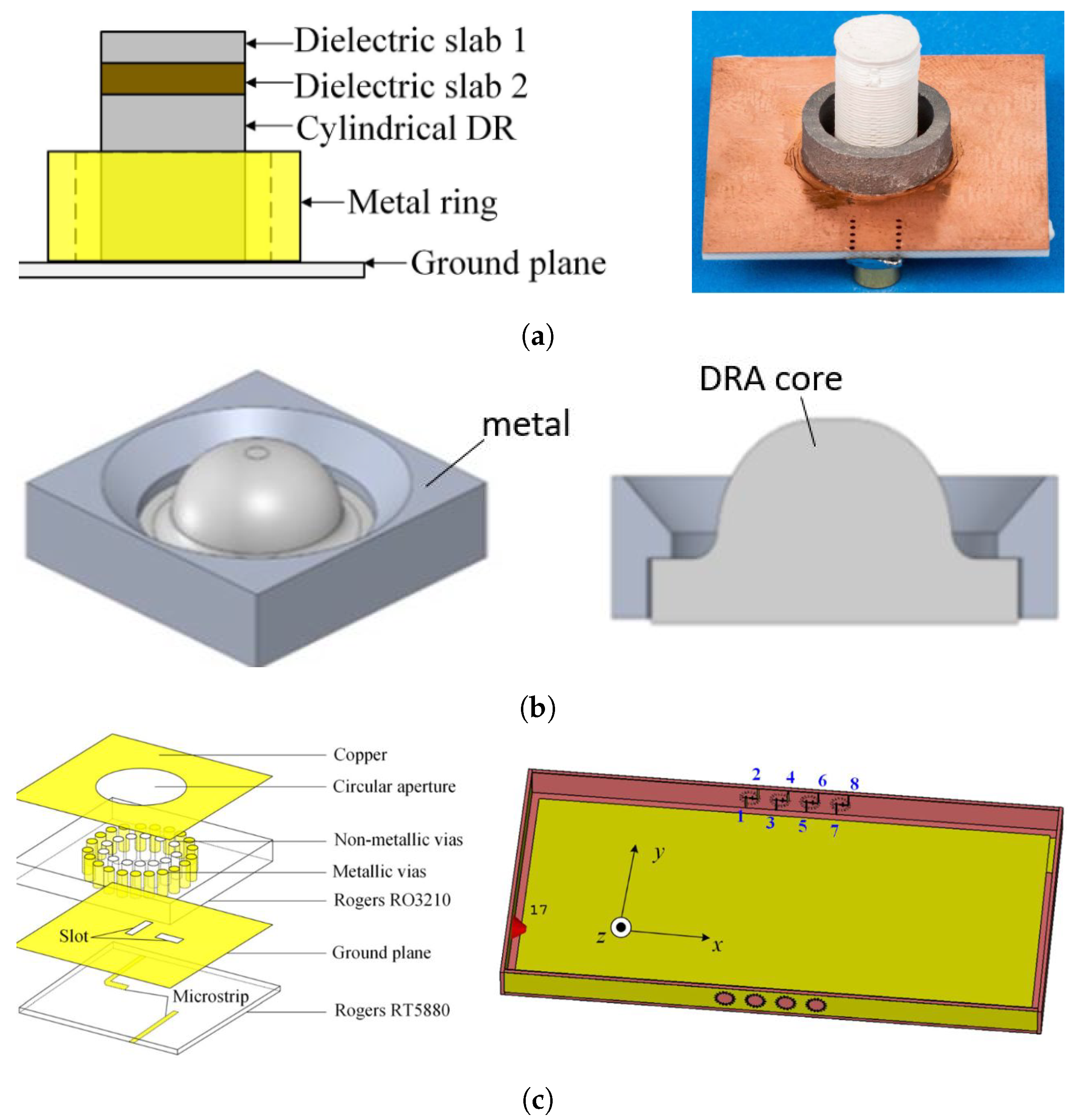
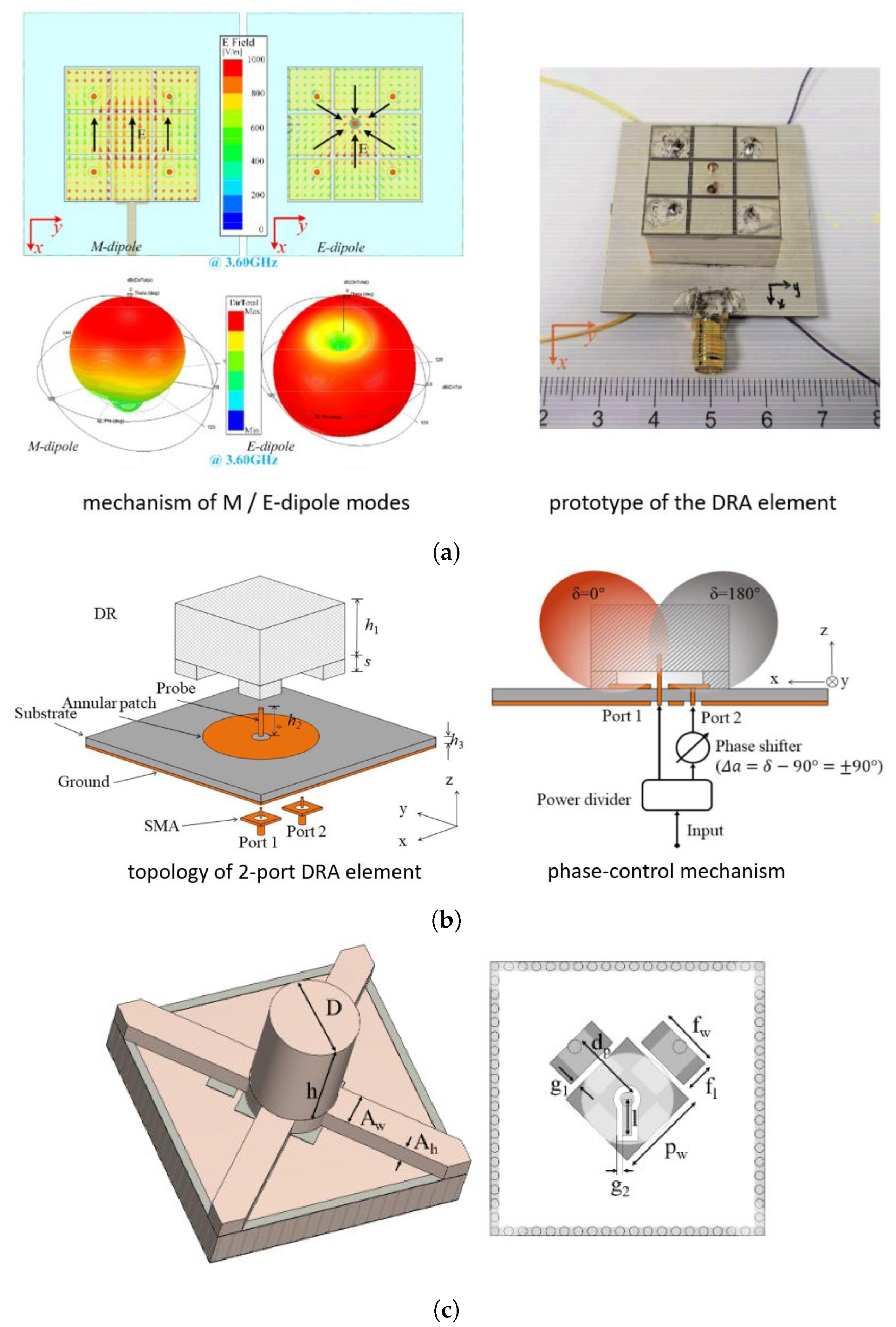
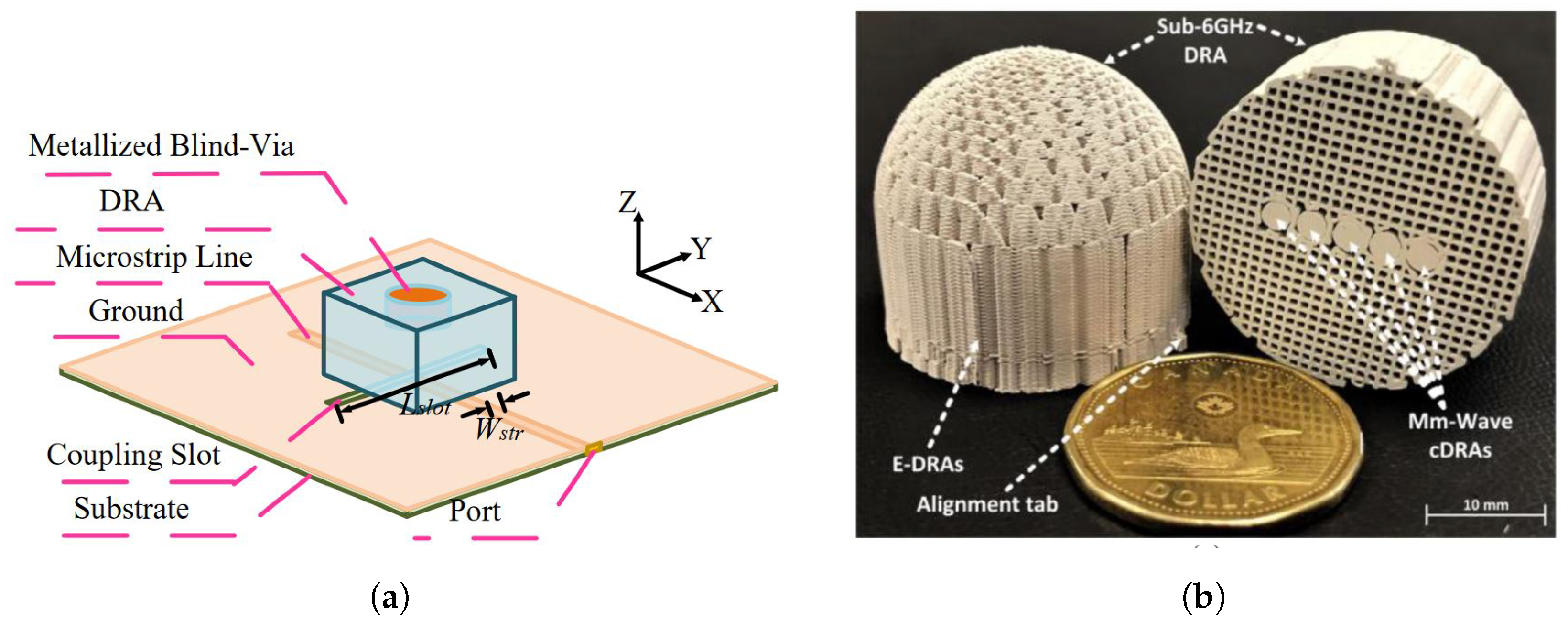
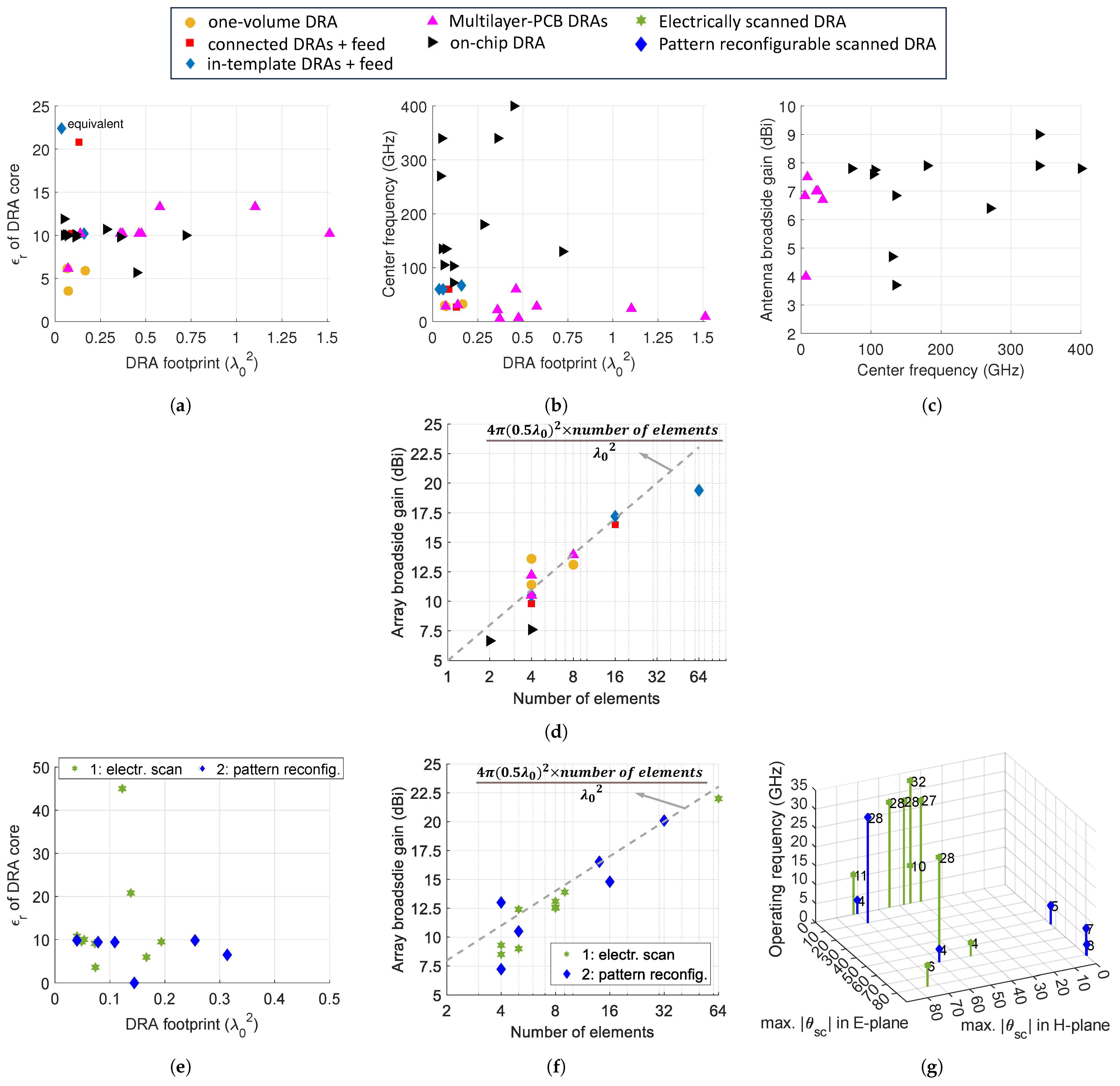
| DRA Type | Feed and Polarization | Technology | of DRA | and BW (GHz, %) | Volume of DRA () | Gain (dBi) | Rad. Eff. 7 (%) | Array and Spacing () | |
|---|---|---|---|---|---|---|---|---|---|
| [14] | R. DRA 1 | SIW 4, LP, CP 5 | 1-layer PCB | 6.15 | 30, 1 | 0.25 × 0.27 × 0.20 | 13.6 arr,M | N/A | 1 × 4 and 2 × 2, 0.85 |
| [15] | R. DRA, | cavity backed, LP 6 | LTCC | 5.9 | 32.5, 47.1 | 0.37 × 0.45 × 0.17 | 11.4 arr,M | 70–85 t | 1 × 4, 0.4 |
| [16] | R. DRA, | SIW, LP | 1-layer PCB | 3.55 | 28, 10 | 0.49 × 2.1 × 0.15 | 13.1 arr | ≥70 t | 1 × 8, 0.48 |
| [17] | R. DRA rings, connected | slot, LP | glued on PCB | 20.8 | 26.8, 20 | 0.30 × 0.44 × 0.07 | ∼9.8 arr,M | 91 ele | 1 × 4, 0.64 |
| [19] | R. DRA rings, connected | slot, LP | glued on PCB | 10.2 | 60, 13 | 0.99 × 1.1 × 0.25 | ∼21 arr,M | 88 arr | 4 × 4, 0.99, 1.1 |
| [18] | C. DRA 2, connected | slot, LP | assemble 2 PCBs | 10.2 | 60, 24 | 0.30 × 0.3 × 0.127 | 16.5 arr,M | ≥71% | 4 × 4, 0.58 |
| [32] | R. DRA stacked | SIW, LP | in-template, PCB | 10.2 + 2.2 | 67, 16.4 | 0.40 × 0.40 × 0.18 | 17.2 arr,M | 72.3 | 4 × 4, 0.67 |
| [22] | R. DRA | slot, LP | in-template, lithography | 10 | 60, 12 | 0.24 × 0.24 × 0.12 | 10.5 arr,M | ≥90 | 2 × 2 |
| [21] | R. DRA + artificial grid | SIW, LP | in-template, lithography | 22.4 eq | 60, 8 | 0.20 × 0.18 × 0.10 | 15.2/19.4 arr,M | 73 arr,M | 4 × 4/8 × 8 |
| [23] | R. SIDRA + air vias + dielectric vias | slot, dual LP | multilayer PCB | 10.2 | 5.5, 35 | 0.61 × 0.61 × 0.09 | 6.84 M | 77 | |
| [24] | R. SIDRA + air vias + dielectric vias | slot, LP | multilayer PCB | 10.2 | 9, 33 | 1.25 × 1.21 × 0.11 | 6–8.7 | ∼92 | |
| [25] | R. SIDRA + air vias + dielectric vias | slot, CP | multilayer PCB | 10.2 | 6.8, 25.4 | 0.69 × 0.69 × 0.09 | 3.45–4.75 | ≥60 | |
| [26] | R. SIDRA+ air vias + metal vias | slot, dual LP | multilayer PCB | 10.2 | 21.7, 24 | 0.60 × 0.60 × 0.10 | 6–8 | N/A | |
| [27] | C. SIDRA + air vias and cavity + metal vias | slot, CP | multilayer PCB | 13.3 | 24, 35 | 1.05 × 1.05 × 0.12 | 6–8.15 M | ||
| [28] | C. SIDRA + air vias + metal vias + strips | slot, LP | multilayer PCB | 13.3 | 28, 5 | 0.76 × 0.76 × 0.11 | ∼12.2 arr,M | 67 t | 2 × 2 |
| [29] | C. SIDRA + air vias + metal vias | slot, CP | multilayer PCB | 10.2 | 60, 12 | 0.68 × 0.68 × / e | 9–12 arr,M | 70 M,arr | 2 × 2 |
| R. SIDRA + SIGW 3 cavity | microstrip line, LP | multilayer PCB | 10.2 | 31, 12 | 0.29 × 0.48 × 0.09 | 6–7.85 | N/A | ||
| [31] | R. SIDRA + SIGW 3 cavity | microstrip line, LP | multilayer PCB | 6.15 | 28, 13.8 | 0.38 × 0.19 × 0.112 | 13.94 arr | N/A | 1 × 8, 0.56 |
| Year | DRA Design Feature and Feed Structure | Chip Technology | f0 (GHz) and FBW (%) | DRA Size () | Gain (dBi) | Rad. Eff. (%) | ||
|---|---|---|---|---|---|---|---|---|
| [44] | 2018 | spherical alumina DRA, self-aligns on cutout on BEOL | 10.1 | silicon-based | 105, 8 | D = 0.28 1 | 7–8.5 M | 60–80 |
| [45] | 2020 | 10.7 | / | 180, 11 | D = 0.6 1 | 7.9 M | 80 | |
| [46] | 2019 | spherical DRA + partially reflective superstructure (PRS) | 9.8 | / | 72, 5.6 | DRA D = 0.38, superstrate D = 3.68 1 | 7.9/17.8 wo/w,M | 70 |
| 10.1 | / | 103, 9.1 | 7.6/18.4 wo/w,M | 70–80 | ||||
| [47] | 2012 | 3 stacked RDRAs, coupled meandered slot | 10, 2.4, 10 | 0.18 μm CMOS | 130, 11 | 0.8 × 0.9 × 0.66 | 4.7 M | 43 |
| [48] | 2014 | RDRA in , mode, coupled slot | 10 | 0.18 μm CMOS | 135, 7 | 0.27 × 0.27 × 0.6–1 | 6.2–7.5 M | 46–42 |
| RDRA in half mode | 10 | 0.18 μm CMOS | 135, 13 | 0.27 × 0.27 × 0.1 | 3.7 M | 62 | ||
| [49] | 2017 | RDRA in mode, coupled slot | 10 | 0.18 μm CMOS | 135, 10 | 0.27 × 0.27 × 0.1 | 6.3/7 M,arr | / |
| RDRA in mode, coupled slot | 10 | 0.18 μm CMOS | 135, 10 | 0.3 × 0.17 × 0.6 | 7/8.2 M,arr | / | ||
| [50] | 2018 | RDRA, patch feed | / | 0.1 μm GaAs pHEMT | 270, 17 | 0.19 × 0.22 × 0.54 | 6.4 | 75 |
| [51] | 2017 | silicon RDRA in mode, patch feed | 11.9 | 0.18 μm CMOS technology | 340, 7.3 | 0.22 × 0.22 × 0.55 | ∼7.9 | 74 |
| [42] | 2015 | stacked alumina RDRA, patch feed | 9.8, 2.1 | 0.13 μm SiGe BiCMOS | 340, 12 | 0.6 × 0.6 × 0.46 | 8–10 M | 65–80 M |
| [43] | 2022 | AMC backed quartz RDRA + diamond layer + lens, patch feed | 5.68, 3.75 | 1:35 nm mHEMT | 400, 25.6 | 0.67 × 0.67 × 0.6 wo | 27 M/7.8, D,wo/w | 50–66 |
| DRA Type | Feed and Polarization | Beam Steer Method | of DRA | and BW (GHz, %) | Volume of DRA () | Array Broadside Gain (dBi) and Rad. Eff. (%) | Array and Spacing () | E, H, or D Plane Scan Range (±,°) | |
|---|---|---|---|---|---|---|---|---|---|
| [56] | CDRA + hemispherical DRA + metal cavity | LP | electro. scan. | 9.5 | 28, 10 | 0.44 × 0.44 × 0.09 | 22 arr,e, 80 | 8 × 8, 0.44 | 60, 60, 60 |
| [57] | RDRA + parasitic strip walls | LP | electro. scan. | 9.5 | 5.5, 5.5 | 0.22 × 0.22 × 0.44 | 12.5 2, / | 1 × 8 and 8 × 8, 0.4 | 80, 75, / 3 |
| [58] | RDRA + metasurface | LP | electro. scan. | 9.1 | 3.55, 12.8 | 0.33 × 0.22 × 0.09 | 9 4,M, 81 | 1 × 5 and 4 × 4, 0.4 | 60, 45, / |
| [59] | CDRA stacked + outer ring | slot fed, LP | electro. scan. | 10, 3, and 3.4 | 10.7, 14.9 M | 0.23 × 0.23 × 0.41 | 13.9 arr,M, / | 1 × 9, 0.45 | /, 72, / |
| [60] | RDRA + parasitic DR strips | LP/CP | electro. scan. | 45 and 69 | 10, 17 | 0.35 × 0.35 × 0.11 | 12.4 arr, / | 1 × 5, 0.5 | /, 45, / |
| [61] | Ring RDRA + strip | LP | electro. scan. | 20.8 | 26.9, 19.5 | 0.3 × 0.46 × 0.09 | ≥9.3 arr,M, 89.6 | 1 × 4, 0.5 | /, 40, / |
| [36] | CDRA + air vias + metal vias | DUAL LP | electro. scan. | 10.8 | 27.5, 15 | 0.2 × 0.2 × 0.09 | 12.6 Mobi, 95 | 2 × 1 × 4 Mobi, 0.5 | /, 28–138, / |
| [16] | R. DRA + metasurface | LP | electro. scan. | 3.55 | 28, 10 | 0.49 × 2.1 × 0.15 | 13.1 arr, ≥70 t | 1 × 8, 0.48 | 0, 55, / |
| [15] | SIW DRA | LP | electro. scan. | 5.9 | 32.5, 47.1 | 0.37 × 0.45 × 0.17 | 6–11.4 arr,M, 70–85 t | 1 × 4, 0.43 | /, 45, / |
| [62] | RDRA + metasurface | LP | pattern-reconfig. 1 | 9.4 | 3.65, 14.1 | 0.28 × 0.28 × 0.11 | 10.5 M, 78.4 M | 1 × 5, 0.5 | /, 70, / M |
| [63] | CDRA + metasurface | LP | pattern-reconfig. | 9.4 | 3.5, 12.8 | 0.33 × 0.33 × 0.09 | 14.8 arr,M, 77 M | 4 × 4, 0.46 | 60, 60, 75 M |
| [64] | RDRA + ring-shape DRA | LP | pattern-reconfig. | 9.8 | 4.9, 16.8 M | 0.5 × 0.51 × 0.28 | 13 e, / | 1 × 4, 0.95 | 15–60, /, / |
| [65] | RDRA + air gap | probe fed, LP | pattern-reconfig. | / | 3, 3.3 | 0.38 × 0.38 × / | 7.22 arr,M, / | 1 × 4, 0.5 | 0–81, /, / |
| [70] | RDRA | ring and probe fed, LP | pattern-reconfig. | 9.8 | 7, 14 | 0.2 × 0.2 × / | 16.53 arr, 96 | 1 × 14, 0.46 | 80, /, / |
| [66] | CDRA + diagonal strip | patch fed, LP | pattern-reconfig. | 6.45 | 28, 11 | 0.56 × 0.56 × / | 20.1 arr, 70 t | 8 × 4, 0.7, 0.56 | 20–30, 70, / |
| Topology | Feed and Polarization | Technology | and BW | of DRA | DR Modes | Volume () | Gain (dBi) | Scan Angle | |
|---|---|---|---|---|---|---|---|---|---|
| [73] | DRA + patch | Shared slot, LP | SIDRA | 24, 3 | 10.2 | 6.32 | |||
| Printed patch | 5.2, 2 | 0.36 × 0.36 × 0.027 | 3.93 | ||||||
| [74] | DRA + printed strip | Shared slot, dual LP | DR in PCB template | 39, 12.56 | 45 | , | 6.4 | ±40° | |
| Printed strip, stub | 28, 14.11 | 3.54 | 0.34 × 0.36 × 0.1 | 6.8 | ±50° | ||||
| [75] | Multimode RDRA | Shared slot, LP | PCB + via | 38, 9.7 | 3.55 | 14.2 1 | |||
| 16, 35.3 | 0.32 × 0.32 × 0.2 | 10.6 1 | |||||||
| [76] | Encapsulated DRA | Slots, LP | 3D printing | 30.5, 27 | 9 | 18 2 | ±32° | ||
| 3.6, 33 | 4 | 0.87 × 0.87 × 0.35 | 7.2 |
Disclaimer/Publisher’s Note: The statements, opinions and data contained in all publications are solely those of the individual author(s) and contributor(s) and not of MDPI and/or the editor(s). MDPI and/or the editor(s) disclaim responsibility for any injury to people or property resulting from any ideas, methods, instructions or products referred to in the content. |
© 2024 by the authors. Licensee MDPI, Basel, Switzerland. This article is an open access article distributed under the terms and conditions of the Creative Commons Attribution (CC BY) license (https://creativecommons.org/licenses/by/4.0/).
Share and Cite
Zhang, Y.; Ogurtsov, S.; Vasilev, V.; Kishk, A.A.; Caratelli, D. Advanced Dielectric Resonator Antenna Technology for 5G and 6G Applications. Sensors 2024, 24, 1413. https://doi.org/10.3390/s24051413
Zhang Y, Ogurtsov S, Vasilev V, Kishk AA, Caratelli D. Advanced Dielectric Resonator Antenna Technology for 5G and 6G Applications. Sensors. 2024; 24(5):1413. https://doi.org/10.3390/s24051413
Chicago/Turabian StyleZhang, Yingqi, Stanislav Ogurtsov, Vasilii Vasilev, Ahmed A. Kishk, and Diego Caratelli. 2024. "Advanced Dielectric Resonator Antenna Technology for 5G and 6G Applications" Sensors 24, no. 5: 1413. https://doi.org/10.3390/s24051413
APA StyleZhang, Y., Ogurtsov, S., Vasilev, V., Kishk, A. A., & Caratelli, D. (2024). Advanced Dielectric Resonator Antenna Technology for 5G and 6G Applications. Sensors, 24(5), 1413. https://doi.org/10.3390/s24051413








